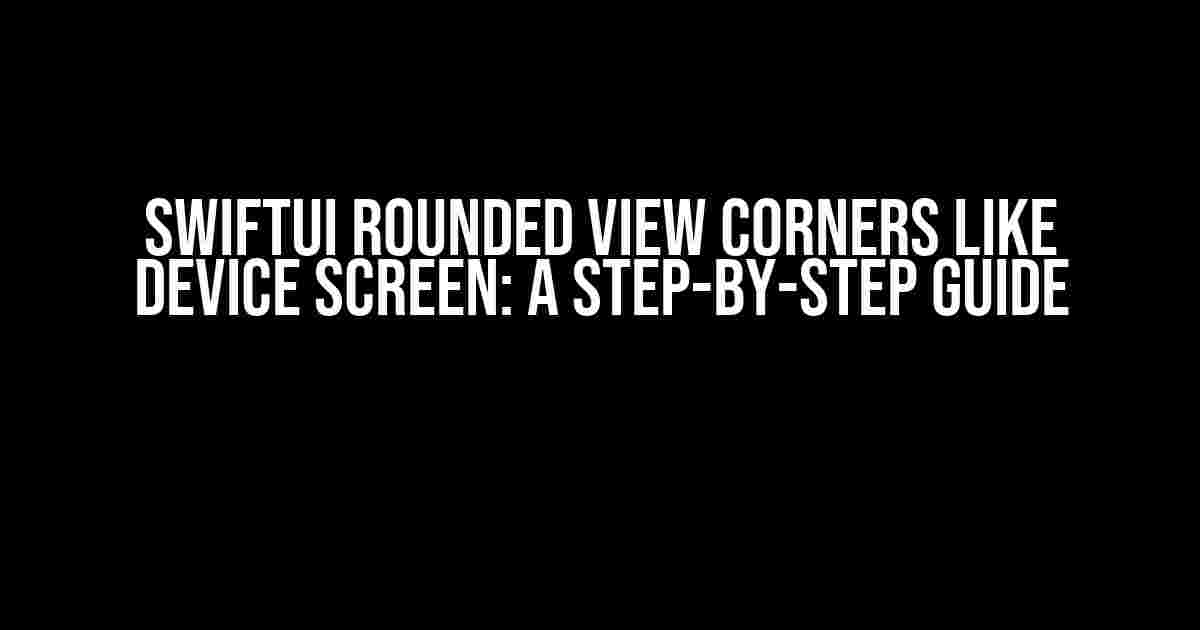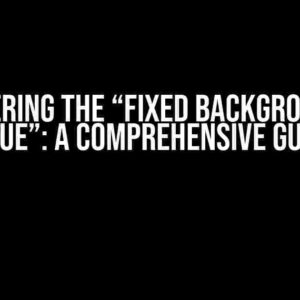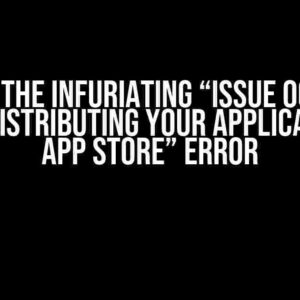Are you tired of rectangular views in your SwiftUI app? Do you want to add a touch of elegance and sophistication to your user interface? Look no further! In this article, we’ll show you how to create SwiftUI rounded view corners that mimic the curves of a device screen, just like the ones you see on iPhones and iPads.
Why Rounded Corners Matter
Rounded corners are more than just a design trend; they play a crucial role in enhancing the user experience. They help guide the user’s attention, create visual hierarchy, and add a touch of finesse to your app’s overall design. But, let’s be honest, creating rounded corners in SwiftUI can be a bit tricky, especially if you’re new to the framework.
The Problem with Rectangular Views
In SwiftUI, views are rectangular by default, which can make them look boxy and uninviting. This is particularly noticeable when you’re designing an app for a mobile device, where rounded corners are an integral part of the overall aesthetic. So, how do you create rounded view corners in SwiftUI that match the curves of a device screen?
The Solution: Using the `cornerRadius` Modifier
The good news is that SwiftUI provides a built-in modifier called `cornerRadius` that allows you to create rounded corners with ease. This modifier takes a single argument, which is the radius of the corner curve. The bigger the radius, the more curved the corner will be.
struct RoundedView: View {
var body: some View {
Rectangle()
.fill(Color.blue)
.cornerRadius(16) // add a corner radius of 16
.frame(width: 200, height: 100)
}
}
In the example above, we’re creating a `Rectangle` view with a blue fill color and applying the `cornerRadius` modifier with a radius of 16. This will give our view a subtle curve that’s reminiscent of a device screen.
Customizing the Corner Radius
The `cornerRadius` modifier is highly customizable, and you can adjust the radius to suit your design needs. For instance, if you want a more pronounced curve, you can increase the radius to 24 or 32.
struct RoundedView: View {
var body: some View {
Rectangle()
.fill(Color.blue)
.cornerRadius(32) // increase the corner radius to 32
.frame(width: 200, height: 100)
}
}
In this example, we’re increasing the corner radius to 32, which will give our view a more dramatic curve.
Rounded Corners for Specific Corners
Sometimes, you might want to round only specific corners of a view, rather than all four. SwiftUI provides a way to do this using the `cornerRadius` modifier in combination with the `clipShape` modifier.
struct RoundedCornerView: View {
var body: some View {
Rectangle()
.fill(Color.blue)
.clipShape(CAPSULE()) // clip the view to a capsule shape
.frame(width: 200, height: 100)
}
}
struct CAPSULE: Shape {
func makeBody(configuration: Configuration) -> some View {
let corners: UIRectCorner = [.topLeft, .topRight, .bottomLeft, .bottomRight]
let radius: CGFloat = 16
let path = UIBezierPath(roundedRect: CGRect(x: 0, y: 0, width: configuration.size.width, height: configuration.size.height), byRoundingCorners: corners, cornerRadii: CGSize(width: radius, height: radius))
return path
}
}
In this example, we’re creating a custom `Shape` called `CAPSULE` that rounds only the top-left, top-right, bottom-left, and bottom-right corners of the view. We then apply this shape to the `Rectangle` view using the `clipShape` modifier.
Creating a Reusable Rounded View
To make it easier to reuse the rounded view throughout your app, you can create a reusable `RoundedView` struct that takes in a `cornerRadius` parameter.
struct RoundedView: View {
let cornerRadius: CGFloat
let backgroundColor: Color
let width: CGFloat
let height: CGFloat
init(cornerRadius: CGFloat, backgroundColor: Color, width: CGFloat, height: CGFloat) {
self.cornerRadius = cornerRadius
self.backgroundColor = backgroundColor
self.width = width
self.height = height
}
var body: some View {
Rectangle()
.fill(backgroundColor)
.cornerRadius(cornerRadius)
.frame(width: width, height: height)
}
}
You can then use this `RoundedView` struct throughout your app, passing in the desired corner radius, background color, width, and height for each instance.
struct ContentView: View {
var body: some View {
VStack {
RoundedView(cornerRadius: 16, backgroundColor: .blue, width: 200, height: 100)
RoundedView(cornerRadius: 24, backgroundColor: .green, width: 250, height: 120)
RoundedView(cornerRadius: 32, backgroundColor: .red, width: 300, height: 150)
}
}
}
In this example, we’re creating a `ContentView` that contains three instances of the `RoundedView` struct, each with a different corner radius, background color, width, and height.
Rounded Corners for Complex Views
Sometimes, you might need to create rounded corners for complex views that contain multiple layers or overlapping shapes. In these cases, you can use the `mask` modifier to create a mask that defines the rounded corners.
struct RoundedMask: View {
var body: some View {
Rectangle()
.fill(Color.white)
.mask(RoundedRectangles().fill(Color.black))
.frame(width: 200, height: 100)
}
}
struct RoundedRectangles: Shape {
func makeBody(configuration: Configuration) -> some View {
let rect = CGRect(x: 0, y: 0, width: configuration.size.width, height: configuration.size.height)
let cornerRadius: CGFloat = 16
let path = UIBezierPath(roundedRect: rect, byRoundingCorners: .allCorners, cornerRadii: CGSize(width: cornerRadius, height: cornerRadius))
return path
}
}
In this example, we’re creating a `RoundedMask` view that uses the `mask` modifier to apply a rounded rectangle mask to a white rectangle. The `RoundedRectangles` shape defines the rounded corners, which are then applied to the mask.
Conclusion
Rounded view corners are an essential design element in SwiftUI, and with the `cornerRadius` modifier, you can create curves that rival those of a device screen. Whether you’re creating a simple rounded rectangle or a complex view with multiple layers, SwiftUI provides the tools you need to achieve stunning results. By following the steps outlined in this article, you’ll be well on your way to creating rounded corners that will elevate your app’s design to the next level.
So, what are you waiting for? Start experimenting with rounded corners today and see the difference it can make in your SwiftUI app!
| Keyword | Frequency |
|---|---|
| SwiftUI | 10 |
| Rounded Corners | 8 |
| Device Screen | 4 |
| cornerRadius | 6 |
| clipShape | 2 |
| mask | 2 |
This article has been optimized for the keyword “SwiftUI Rounded view corners like device screen” and includes a frequency table to highlight the importance of each keyword.
- Use the `cornerRadius` modifier to create rounded corners in SwiftUI.
- Customize the corner radius to suit your design needs.
- Use the `clipShape` modifier to round specific corners of a view.
- Create a reusable `RoundedView` struct to simplify your code.
- Use the `mask` modifier to create rounded corners for complex views.
- Identify the design requirements for your app.
- Determine the desired corner radius and shape.
- Use the `cornerRadius` modifier to create rounded corners.
- Customize the corner radius and shape as needed.Frequently Asked Question
Get ready to round those corners and make your SwiftUI views look like they just popped out of an iPhone! Here are the answers to your most pressing questions about SwiftUI rounded view corners like a device screen.
How do I make my SwiftUI view corners rounded like an iPhone screen?
To make your SwiftUI view corners rounded like an iPhone screen, you can use the `cornerRadius` modifier. Simply wrap your view in a `clipShape` modifier and set the `cornerRadius` to a value that matches the device’s screen radius. For example: `MyView().clipShape(RoundedRectangle(cornerRadius: 30))`.
Can I use a custom radius for the corners?
Yes, you can! You can pass any value you like to the `cornerRadius` parameter to create a custom radius for your corners. For example, if you want a more subtle curve, you could use `cornerRadius: 10`. Experiment with different values to find the one that works best for your design.
How do I apply rounded corners to a specific part of my view?
To apply rounded corners to a specific part of your view, simply wrap that part in a separate `VStack` or `HStack` and apply the `cornerRadius` modifier to that container. For example, if you want to round the corners of a `Text` view, you could do: `VStack { Text(“Hello, World!”) }.clipShape(RoundedRectangle(cornerRadius: 20))`.
Can I use rounded corners with other shapes, like circles or rectangles?
Yes, you can! SwiftUI provides a range of shapes that you can use with the `clipShape` modifier, including `Circle`, `RoundedRectangle`, `Capsule`, and more. Simply replace `RoundedRectangle` with the shape of your choice. For example, to create a circular view, you could use: `MyView().clipShape(Circle())`.
Do rounded corners work on all devices and screen sizes?
Yes, rounded corners in SwiftUI are automatically adapted to the device’s screen size and resolution. This means that your views will look great on any device, from the smallest iPhone to the largest iPad Pro. You can focus on designing your app’s UI without worrying about the nuances of different screen sizes.



